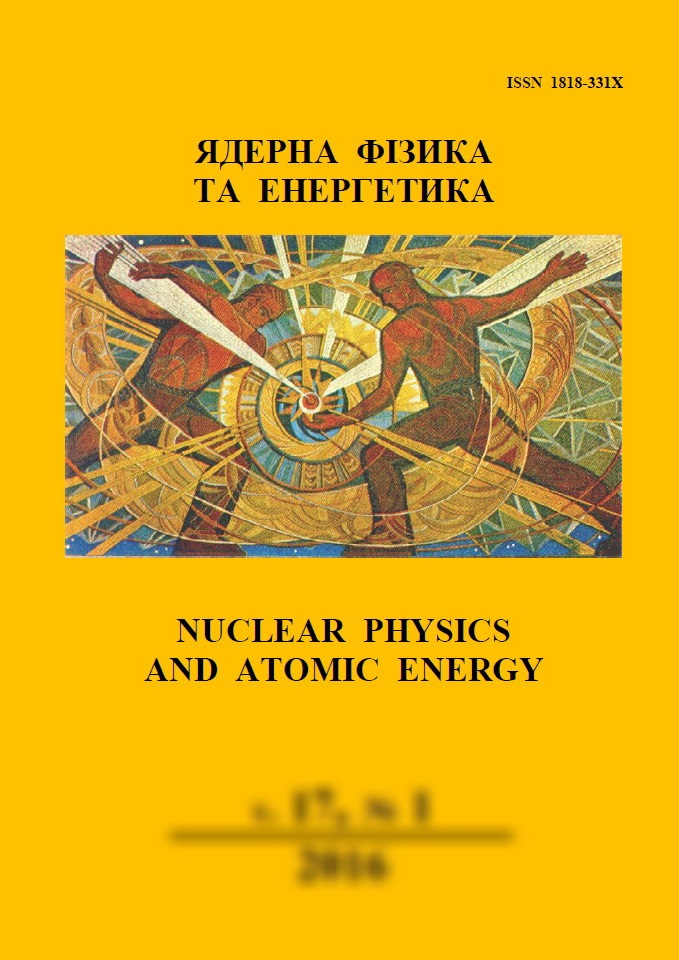 |
ядерна ф≥зика та енергетика
Nuclear Physics and Atomic Energy
ISSN:
1818-331X (Print), 2074-0565 (Online)
Publisher:
Institute for Nuclear Research of the National Academy of Sciences of Ukraine
Languages:
Ukrainian, English
Periodicity:
4 times per year
Open access peer reviewed journal
|
Nucl. Phys. At. Energy 2001, volume 2, issue 4, pages 45-55.
Section: Plasma Physics.
Published online: 30.12.2001.
 Full text (en)
Full text (en)
https://doi.org/10.15407/jnpae2001.04.045
Physics design of CHS-qa based on CHS experiments
K. Matsuoka1, S. Okamura1, S. Nishimura1, M. Isobe1, C. Suzuki1, A. Shimizu2, A. Fujisawa1, K. Ida1, T. Minami1, H. Iguchi1, Y. Yoshimura1, M. Osakabe1, I. Nomura1, S. Murakami1, M. Yokoyama1, N. Nakajima1, T. Hayashi1, K. Itoh1, P. Merkel3, M. Drevlak3, C. Nuhrenberg3, S. Gori3, R. Zille3, J. Nuhrenberg3
1National Institute for Fusion Science, Toki, Japan
2Nagoya University, Nagoya, Japan
3Max-Planck-Institute fuer Plasmaphysik, Greifswald, Germany
Abstract:
CHS-qa, a quasi-axisymmetric helical device, has been designed as a post-CHS device in NIFS, the
main purpose being to improve the neoclassical and anomalous transports of a helical plasma. In CHS, a
variety of improved modes have been observed. On the basis of these improved modes further improvement
of transports is to be pursued in CHS-qa by taking into consideration methods verified in other toroidal
magnetic configurations, e.g. large velocity / radial electric field shear, and maximum J criterion. The
toroidal viscosity is shown to be smaller by two orders than that of CHS and the poloidal viscosity, which is
mainly determined by the aspect ratio with additional contribution from residual ripples, is also smaller by
roughly l order than that of conventional helical system. The maximum J criterion is satisfied at the edge
region in the vacuum configuration by the presence of small residual ripples and the region where the
criterion is satisfied is extended to the core region due to the stellarator shear produced by the bootstrap
current in a finite beta plasma. Design priority is put on the low aspect ratio (Ap = 3.2) because of a large
plasma volume: R = 1.5 m, a = 47 cm, B = 1.5 T, toroidal period number N = 2, 10 modular coils per period,
8 additional modular toroidal coils, 3 pairs of poloidal coils. Residual ripples can be controlled with these
coils to keep flexibility in the experiments.
References:
1. J. Nuehrenberg et al. Phys. Lett. A 129 (1988) 113.
https://doi.org/10.1016/0375-9601(88)90080-1
2. J. Nuehrenberg et al. Theory of Fusion Plasmas (Varenna, 1994), Editrice Compositori (Bologna, 1994) p. 3.
3. P. Garabedian Phys. Plasmas 3 (1996) 2483.
https://doi.org/10.1063/1.871965
4. W. Lotz et al. Plasma Physics and Controlled Nuclear Fusion Research, Proc. 13th Int. Conf. Washington, 1990 (IAEA, Vienn, 1991) Vol. 2, p. 603.
5. K. Matsuoka et al. Plasma Physics and Controlled Nuclear Fusion Research, Proc. 12th Int. Conf. Nice, 1988 (IAEA, Vienna, 1989) Vol. 2, p. 411.
6. K. Toi et al. Plasma Phys. Control. Fusion 38 (1996) 1289.
https://doi.org/10.1088/0741-3335/38/8/024
7. M. Hirsch et al. Plasma Physics and Controlled Nuclear Fusion Research, Proc. 16th Int. Conf. Montreal, 1996 (IAEA, Vienna, 1997) Vol. 2, p. 315.
8. K. Ida et al. Nucl. Fusion 39 (1999) 1649.
https://doi.org/10.1088/0029-5515/39/11Y/304
9. A. Fujisawa et al. Phys. Rev. Lett. 82 (1999) 2669.
https://doi.org/10.1103/PhysRevLett.82.2669
10. A. Fujisawa et al. Phys. Rev. Lett. 81 (1998) 2256.
https://doi.org/10.1103/PhysRevLett.81.2256
11. A. Fujisawa et al. Physics of Plasmas 7 (2000) 4152.
https://doi.org/10.1063/1.1290483
12. K. Ida et al. Phys. Rev. Letters 67 (1991) 58.
https://doi.org/10.1103/PhysRevLett.67.58
13. K. Matsuoka et al. Plasma Phys. Reports 23 (1997) 542.
14. S. Okamura et al. 10th. Int. Toki-conf. Journal of Plasma and Fusion Research 3 (2000) 73.
15. S. Okamura et al. Plasma Physics and Controlled Nuclear Fusion Research, Proc. 18th Int. Conf. Sorrento, 2000. IAEA-CN-77/ICP/16.
16. K. Matsuoka et al. 11th Int. Toki-conf., to be published in Journal of Plasma and Fusion Research, SERIES, 4 (2001).
17. A. H. Glasser et al. Phys. Fluids 17 (1974) 181.
https://doi.org/10.1063/1.1694585
18. C. Suzuki et al. 11th Int. Toki-conf., to be published in Journal of Plasma and Fusion Research, SERIES, 4 (2001).
19. K. H. Burrell et al. Plasma Physics and Controlled Nuclear Fusion Research, Proc. 12th Int. Conf. Seville, 1994 (IAEA, Vienna, 1995) Vol. 1, p. 221.
20. K. Ida. Plasma Physics Controlled Fusion 40 (1998) 1429.
https://doi.org/10.1088/0741-3335/40/8/002
21. M. Okabayashi et al. Phys. Fluids 15 (1972) 359.
https://doi.org/10.1063/1.1693914
22. S-I. Itoh et al. Comments Plasma Phys. Controlled Fusion 12 (1989) 133.
23. M. Yokoyama et al. Physical Review E 64 (2001) 015401(R).
https://doi.org/10.1103/PhysRevE.64.015401
24. A. Shimizu et al. 11th Int. Toki-conf., to be published in Journal of Plasma and
Fusion Research, SERIES, 4 (2001).
25. M. F. Heyn et al. to be published in Plasma Physics Controlled Fusion.
26. H. E. Mynick et al. Phys. Rev. Lett. 48 (1982) 322.
https://doi.org/10.1103/PhysRevLett.48.322
27. S. Gori et al. Plasma Phys. Control. Fusion 43 (2001) 137.
https://doi.org/10.1088/0741-3335/43/2/304
28. K. Matsuoka et al. Fusion Eng. Design 26 (1995) 135.
https://doi.org/10.1016/0920-3796(94)00170-C
29. S. Okamura et al. Nucl. Fusion 35 (1995) 283.
https://doi.org/10.1088/0029-5515/35/3/I03
30. S. Sakakibara et al. Plasma Physics and Controlled Nuclear Fusion Research. Proc.
18th Int. Conf. Sorrento, 2000. IAEA-CN-77/EXP3/12
31. J. Fujita et al. IEEE Transaction on Plasma Science PS-9 (1981) 180.
32. WVII-A TEAM. Nucl. Fusion 20 (1980) 1093.
https://doi.org/10.1088/0029-5515/20/9/008
33. K. Matsuoka et al. Nucl. Fusion 17 (1979) 1123.
https://doi.org/10.1088/0029-5515/17/6/002
34. E. Sallander et al. Nucl. Fusion 40 (2000) 1499.
https://doi.org/10.1088/0029-5515/40/8/308
35. T. Hayashi et al. Phys. Plasmas 1 (1994) 3262.
https://doi.org/10.1063/1.870478
